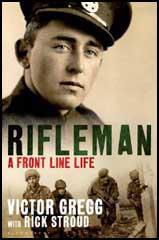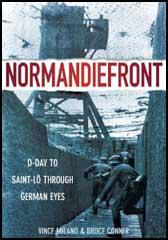Spartacus Review
Volume 53: 28th April, 2011
Second World War

Title: Rifleman: A Front Line Life
Author: Victor Gregg
Editor:
Publisher: Bloomsbury
Price: £17.99
Bookshop: Amazon
Spartacus Website: Second World War
Category:
Born into a working-class family in London in 1919, Victor Gregg enlisted in the Rifle Brigade at nineteen, was sent to the Middle East and saw action in Palestine. Following service in the western desert and at the battle of Alamein, he joined the Parachute Regiment and in September 1944 found himself at the battle of Arnhem. When the paratroopers were forced to withdraw, Gregg was captured. He attempted to escape, but was caught and became a prisoner of war; sentenced to death in Dresden for attempting to escape and burning down a factory, only the allies' infamous raid on the city the night before his execution saved his life. Gregg's fascinating story, told in a voice that is good-natured and completely original, continues after the end of the war. In the fifties he became chauffeur to the Chairman of the Moscow Norodny bank in London, involved in shady dealings and strange meetings with MI5, MI6 and the KGB. His adventures, though, were not over - in 1989, on one of his many motorbike expeditions into Eastern Europe, he found himself at a rally of 700 people in a field in Sopron at a fence that formed part of the barrier between the Soviet Union and the West. Vic cut the wire, and a few weeks later the Berlin Wall itself was destroyed - a truly unexpected coda to an incredible life lived to the full. This is the story of a true survivor.

Title: Normandiefront
Author: Vince Milano & Bruce Conner
Editor:
Publisher: History Press
Price: £20.00
Bookshop: Amazon
Spartacus Website: German Army
Category:
You probably already know the basic story of what happened on D-Day - but it is almost certain that your knowledge is based upon books written from the Allied perspective. "Normandiefront" provides a fresh and unique exploration of the greatest seaborne invasion in history. It also explains just why the Americans on Omaha beach suffered the Longest Day of all. As the ramps went down and the Amis plunged into the water, their commanders expected them to face just one battalion of mediocre occupation troops - but the veterans and the new recruits of the 352nd Division were waiting instead. Authors Vince Milano and Bruce Conner have interviewed the surviving members of that formidable fighting force - at the same time amassing a collection of German and Allied photographs and documents, many of which are published here for the first time. The fight to get off the beach and then the seemingly interminable struggle through the bocage - from hedgerow to hedgerow, as the German line fell back only to reform and counter-attack time and time again, all the way to the ruins of St Lo - was one of the most intense ever experienced by any army. General leutnant Dietrich Kraiss' deployment of his men is a fascinating military case study in itself. The General, responsible for the stretch of coastline that included Omaha beach and part of Gold beach, was an Eastern Front veteran, as were many of his men. He was therefore used to facing an adversary who outnumbered and outgunned his forces and was well versed in the tactics of defence and counter-attack. The division actually expected to be sent East any day and had been trained for it. Denied the use of one third of his division during the crucial first hours of the invasion that had been held in reserve by higher commands, he tenaciously held his ground until they were released and then mounted a skilful defensive campaign. The reinforcements needed to contain the Allied breakout from the beachhead never came - partly because German High Command refused to accept that Normandy really was the main invasion target and not Pas de Calais. As the authors point out, 'Any Grenadier in the 352nd could have told them differently.' With over 200 photographs and those priceless interviews with German veterans, "Normandiefront" is an important addition to the literature of World War II, telling as it does the story of how one German division changed the course of the invasion and almost the entire war.

Title: The 2nd Norfolk Regiment
Author: Peter Hart
Editor:
Publisher: Pen & Sword
Price: £17.99
Bookshop: Amazon
Spartacus Website: Second World War
Category:
The Second World War is vanishing into the pages of history. The veterans were once all around us, but their numbers are fast diminishing. While still in their prime many recorded their memories with Peter Hart for the Imperial War Museum. As these old soldiers now fade away their voices from the front are still strong with a rare power to bring the horrors of war back to vivid life. The 2nd Norfolk Regiment were a proud old regular battalion honed in the pre-war traditions of spit and polish at their Britannia Barracks in Norwich. Sent to France they sold their lives to gain time for the retreat to Dunkirk when surrounded by an SS Division at Le Paradis in May 1940. Over 100 of the survivors would be brutally massacred. Back in England they reformed from ordinary drafts of men called up from all over the country. A new battalion was born. Sent to India they met the Japanese head on in the bloody fight for Kohima against the Imperial Japanese Army. As the fighting raged in the jungle the Norfolks were once again right at the very sharp end of modern war. This is their story.

Title: Defense of the Rhine 1944-45
Author: Steven Zaloga
Editor:
Publisher: Osprey
Price: £11.99
Bookshop: Amazon
Spartacus Website: German Army
Category:
The Rhine River represented the last natural defensive barrier for the Third Reich in the fall of 1944. Although Hitler had been reluctant to allow the construction of tactical defense lines in France, the final defense of the Reich was another matter. As a result, construction of a Rhine defense line began in September 1944. Steven J Zaloga examines the multiple phases of construction undertaken to strengthen the Westwall (Siegfried Line), to fortify many of the border villages, and finally to prepare for the demolition of the Rhine bridges. Using detailed maps, color artwork, and expert analysis, this book takes a detailed look at Germany's last line of defense.
